#Stone boxes in ancient cultures
Explore tagged Tumblr posts
Text
Where Are the Gold Plates? An In-Depth Analysis
Contributing writer at Life After Ministries blog posits the following question in their latest post: Where are the Gold Plates? The writer quotes from Bruce R. McConkie’s Mormon Doctrine. Along with quoting from Mormon Doctrine, a quote from Ephesians 4:14 follows with a brief commentary: There’s not a shred of evidence these plates let alone the angel Moroni ever existed except in the mind of…
#1 Corinthians 15:1-4 and the Book of Mormon#Ancient metal plates discoveries#Ancient records on metal plates#Angel Moroni and gold plates#Archaeological evidence Book of Mormon#Biblical archaeology vs. Book of Mormon#Book of Mormon archaeology evidence#Bruce R. McConkie Mormon Doctrine quotes#Challenges to LDS faith and archaeology#Criticism of Mormon Doctrine#Divine purpose of the gold plates#Ephesians 4:14 commentary#Evangelical critiques of LDS beliefs#Faith vs. material evidence in religion#Faith without archaeological proof#Gold plates historical significance#Historical context of gold plates#Joseph Smith gold plates#Joseph Smith translation process#Latter-day Saints gold plates beliefs#Mormon faith and historical artifacts#Stone boxes in ancient cultures#Symbolism of gold plates in LDS faith#Understanding Moroni’s visitation#Where are the Gold Plates?
0 notes
Text


A 4000-Year-Old Stone Box Grave Discovered in Norway
Archaeologists report an extremely important 4,000-year-old stone box grave has been unearthed in Western Norway, describing it as the most unique Stone Age find in Norway in the last 100 years.
This significant find, which archaeologists believe will provide information about how agriculture came to Western Norway, was discovered south of Vestkapp in Selje, Vestland. The grave is four meters long and over two meters wide.
It’s a sensational discovery and the most unique Stone Age finds in Norway in the last 100 years, says Morten Ramstad at the antiquities section at the University of Bergen.
The grave is a ‘hellekistegrave’, or stone box grave, a type of burial site that has previously only been found in Buskerud, Østfold, and Denmark, but never in Western Norway. Such a grave’s finding here is noteworthy and may help explain when agriculture, which first appeared in Norway circa 3950 BC, made its way to Western Norway.
The fact that this type of grave has not been previously found in Western Norway adds to the significance of the discovery.
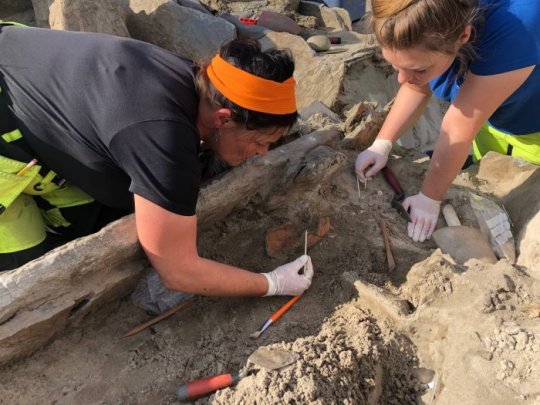
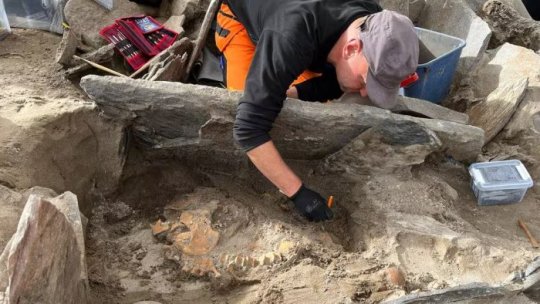
Researchers may be able to ascertain the individuals’ ages, places of origin, and methods of transportation to Western Norway thanks to the exceptionally well-preserved human bone material discovered at the site.
Following the retreat of the great ice sheets, the first inhabitants migrated north into what is now Norway around 10,000 years ago. They were hunter-gatherers who lived off of seafood and game, particularly reindeer. The first agricultural settlements appeared around the Oslofjord between 5,000 and 4,000 BC. Between 1500 BC and 500 BC, agricultural settlements gradually spread throughout southern Norway, while residents north of Trndelag continued to hunt and fish.


The Neolithic period, beginning in 4000 BC, marked the beginning of agriculture in Norway. The Migration Period saw the establishment of the first chieftains and the construction of hilltop forts. Norwegians began to spread across the seas to the British Isles in the eighth century, and later to Iceland and Greenland. The Viking Age also saw the country’s unification.
The discovery of the 4,000-year-old grave in Western Norway adds to our understanding of the region’s agricultural history. The grave’s exceptionally well-preserved condition, as well as the human bone material discovered within it, could provide valuable data for researchers.
By Oğuz Büyükyıldırım.
#A 4000-Year-Old Stone Box Grave Discovered in Norway#ancient grave#ancient tomb#ancient artifacts#archeology#archeolgst#history#history news#ancient history#ancient culture#ancient civilizations#stone age
119 notes
·
View notes
Text




Scarab Bracelet of Tutankhamun,
New Kingdom, late 18th Dynasty, reign of Tutankhamun, ca. 1332-1323 BC.
The scarab bracelet of Tutankhamun is considered a masterpiece of ancient Egyptian jewelry. The rigid gold bracelet is composed of two semicircles joined together by a hinge on one side and a clasp on the other. The central plaque bears a cloisonné scarab inlaid with lapis lazuli.
The scarab, symbol of the morning sun, rebirth and protection in ancient Egyptian culture, was the most popular motif used in jewelry. The small circumference of this bracelet suggests that it was made for King Tutankhamun when he was a child.
The bracelet itself is also inlaid with carnelian, lapis lazuli, and colored glass. It was found in the cartouche shaped box that contained several other objects, including the fine pair of earrings which also seem to have been personal possessions.
In ancient Egypt, scarab bracelets were a popular form of jewelry. The scarab beetle held great significance in Egyptian culture, symbolizing rebirth and protection.
These bracelets were often made of precious materials such as gold or semi-precious stones, and they featured a scarab beetle motif. The scarab beetle was believed to bring good luck and ward off evil spirits.
Scarab bracelets were worn by both men and women and were considered a fashionable accessory as well as a symbol of religious and spiritual beliefs.
The Egyptians adopted the scarab (Ateuchus sacer) as a symbol of the sun god, because they were familiar with the sight of the beetle rolling a ball of dung on the ground and this action suggested to them that the invisible power that rolled the sun daily across the sky could be represented pictorially as a scarab.
From the Tomb of Tutankhamun (KV62), Valley of the Kings, West Thebes. Now in the Egyptian Museum, Cairo. JE 62360
#art#history#design#style#archeology#antiquity#jewellery#jewelry#bracelet#gold#scarab#sun#spiritual#god#tutankhamun#cairo#egypt#pharaon#lapis lazuli#carnelian#glass
477 notes
·
View notes
Text
Writing Notes: Mystical Items & Objects

Examples in Mythology and Literature
Pandora's Box
The god Prometheus stole fire from heaven to give to the human race, which originally consisted only of men
To punish humanity, the other gods created the first woman, the beautiful Pandora
As a gift, Zeus gave her a box, which she was told never to open
However, as soon as he was out of sight she took off the lid, and out swarmed all the troubles of the world, never to be recaptured
Only Hope was left in the box, stuck under the lid
Anything that looks ordinary but may produce unpredictable harmful results can thus be called a Pandora's box
Hermes' Winged Sandals
Also called the Talaria of Mercury
Are winged sandals, a symbol of the Greek messenger god Hermes (Mercury)
They were said to be made by the god Hephaestus of imperishable gold and they flew the god as swift as any bird
Cintamani Stone
Also referred to as the Chintamani
A wish-fulfilling stone that features across both Hindu and Buddhist religions
The stone features as one of many Mani Jewel (i.e., several gems that are mentioned prominently in Buddhist literature) images that can be found in the scripture of Buddhism
In Hinduism, the stone is connected to the gods Ganesha and Vishnu
Usually, it is depicted as a jewel in Vishnu’s possession known as the Kaustubha
The Kaustubha acts as a sign of divine authority
Arcane Artifacts & Objects
Offer a gateway between time past and time present, bringing layers of ancient history and new-world intrigue to a narrative
Such items are typically represented in fiction as works of long-lost knowledge, primordial features or landmarks, and curious objects of mysterious origin
Often lying dormant until the pivotal moment of discovery, these items invite characters and readers alike into a dance with the unknown
Examples: Necronomicon, Genie's Bottle
Necronomicon
Also referred to as the Book of the Dead
It appears in stories by H.P. Lovecraft
A dark grimoire (i.e., a magician's manual for invoking demons and the spirits of the dead) of forbidden knowledge
Used to open gateways of unearthly powers and cosmic horrors
Genie's Bottle
The classic magical item from mythology, also featured in Aladdin
A vessel of wish fulfillment that often leads to dramatic and unexpected consequences
Doorways & Portals
Doorways in fiction serve as gateways between worlds, dimensions, or states of reality, providing characters with universe-hopping capabilities and genre-defying journeys
These portals, whether physical structures or fantastical mechanisms, open up limitless storytelling possibilities, allowing for sudden shifts in setting and introducing elements of surprise and surrealism
Examples:
C.S. Lewis' wardrobe in The Chronicles of Narnia serves as a secret portal to a fantasy world, bridging the mundane with the fantastical
The eponymous board game in Jumanji transports its players into a wild and perilous jungle adventure, wrenching them from the safety of their living room
Jewelry, Gems, and Garments
Along with other various accessories, these serve several narrative functions, from symbolizing power and status to bestowing unique abilities upon their wearers
These items can act as plot catalysts (i.e. MacGuffins), embody character traits, or hold deep cultural or magical significance within a story’s world
Example: The Amulet of Mara in Skyrim not only reduces the cost of Restoration spells but also unlocks marriage options for the player, integrating gameplay with the narrative
Legendary Objects of Power
Carry with them stories of grandeur and lore, passed down through generations and intertwined with the fates of those who wield them
These are the objects that make or break worlds, bestow immense strength, and are frequently considered among the most powerful items in fiction
Example: Though it's never actually been seen, the Kusanagi Sword from Japanese folklore is a fabled sword that represents valor, said to be endowed with divine powers
Machinery and Technologies
Stretch the boundaries of physics and logic to offer a glimpse into what could be possible in alternate or future universes
These innovations, whether grounded in current science or verging on the fantastical, propel narratives forward and deepen the complexity of the story’s world
Writers can leverage these technological wonders to enhance their storytelling, using them to explore themes of power, ethics, and the human relationship with technology
Example: The body shields in Dune generate a protective forcefield around the wearer—advanced technology that current militaries can only dream of
Mundane Everyday Items
Possess extraordinary storytelling potential to transform the unassuming into the unforgettable
Seemingly ordinary, these objects can surprise both characters and readers, unveiling hidden depths and abilities when least expected
These seemingly mundane objects could fall into unsuspecting hands and create chaos or catalyze a hero’s journey
Additionally, they might only reveal their true nature to those worthy or capable of wielding their power, which can set the stage for narratives that are centered around discovery and mastery
Example: Oscar Wilde’s Portrait of Dorian Grey presents art as a vessel for dark magic, encapsulating the protagonist’s sins while he remains untouched by time
Sources: 1 2 3 4 ⚜ Writing Notes & References
#writing notes#fantasy#mythology#literature#greek mythology#writeblr#spilled ink#dark academia#writing reference#poets on tumblr#poetry#writers on tumblr#writing prompt#fiction#light academia#studyblr#booklr#creative writing#writing resources
156 notes
·
View notes
Note
you should talk about your thoughts on rw fanon (looking with huge eyes)
Oh god, there's a lot of major misconceptions have concreted into fanon, mostly around ancient society and ascension.
First things first! Ascension is not death! They are entirely separate things treated entirely separately by the text of the game. I can see where the interpretation is coming from, but it doesn't really align with how the text treats either subject. Five Pebbles may want to remove the self destruction taboo, but from his reaction to the rot it's clear that he doesn't want to die. Conflation of ascension and death only comes up as an offhand possibility that pebbs makes on iterator 4chan, when he's going into the possibilities of scenarios that even the other sliverists are doubtful of! (let me make clear that I am not a sliverist by any means)
Ascension is more of talked about as a form of transcendence, yeah? A Bell, Eighteen Amber Beads talks about their sitution as being "To have grasped at the boundless infinites of the cosmic void…", not as them seeking an end to life.
The beta dialogue goes into more detail, mentioning the "infinities of time and space" and the "boundless fractal planes of spirit and reality...", though this dialogue was cut and it's hard to tell how much it reflects the concept as in the released game.
As for the cultural misconceptions... there's A Lot to talk about, but the first that comes to mind is the common conflation of the five natural urges and the christian concept of sin.
It is true that the negation of urges is mentioned by moon as an alternative method of ascension, but much of what we know about the culture of the people who the fandom calls the ancients (which makes discussion of the depths a mess but that's something for another post entirely) points towards the urges not being seen as shameful.
Even the first urge does not seem to be particularly scorned! Being a warrior is presented as a cause for bragging in the Shaded Citadel pearl, being comparable with being an artist and a fashion legend. The second urge, also does not seem to be suppressed. Multiple sources attribute some level of honour to parenthood! The aforementioned pearl also mentions Seventeen Axes, Fifteen Spoked Wheel as being a "Mother, Father and Spouse" without any hint of shamefulness. Nineteen Spades, Endless Reflections expresses pride about having progeny, mentioning it alongside their owned land and esteem among their peers.
After some peer review, an esteemed friend has told me to add a section on purposed organisms as well! This is not so much my area, so I might be a bit off on some things.
As moon says, the majority of purposed organisms were tubes in boxes, and that the primal fauna of the world are almost entirely extinct. A lot of the fandom seems to ignore the first part, and i can't say I blame them, but the evolution of the creatures is so much weirder than people think.
Concept art for the creatures has this interesting quality to it, where the organic parts of the creatures have an almost... melty quality to them.
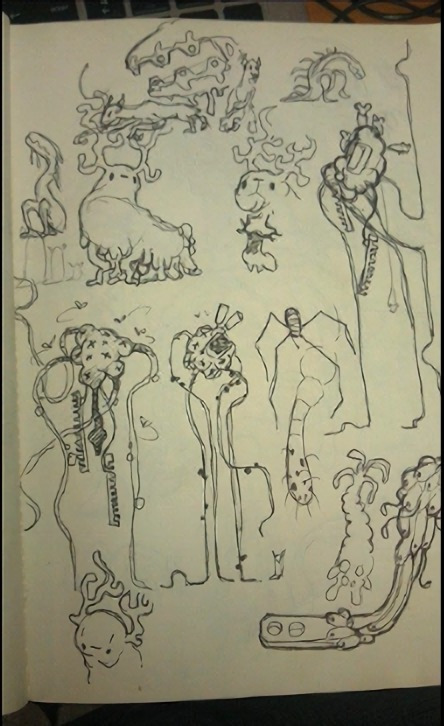
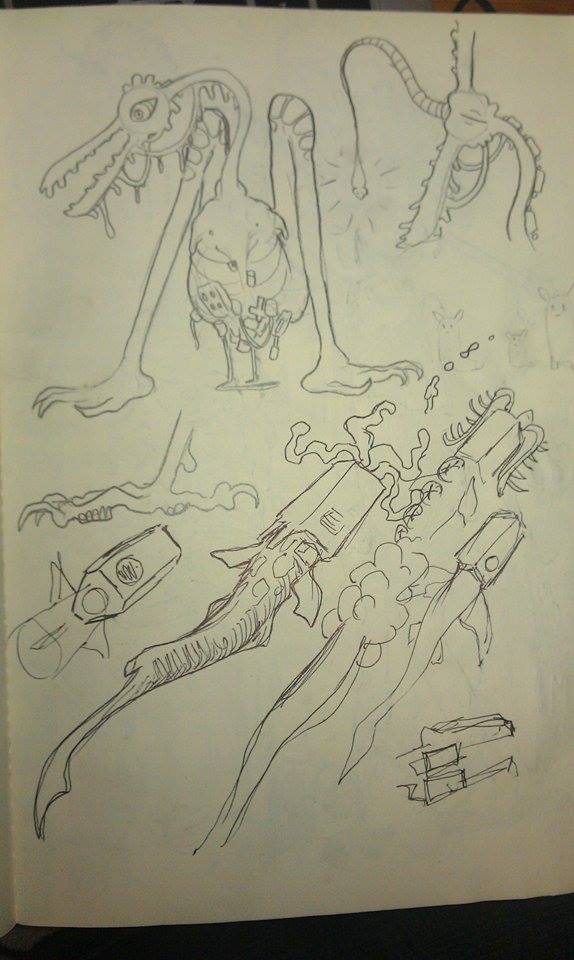
In the concept art, the flesh appears as if it's almost defying the machinery to form an animal shape. It's as if it's conquering its own artificiality the way the foliage grows over the (stone, brick and concrete, not mostly metal as some think!) ruins.
Of course, it's hard to really tell how much of this reflects the finalised concept, most of the integration is much smoother in the game, in line with a seamless kind of biomechanical design. There was always an intention of biomechanical strangeness, as shown in this screenshot of the devlog before the term "slugcat" even existed!
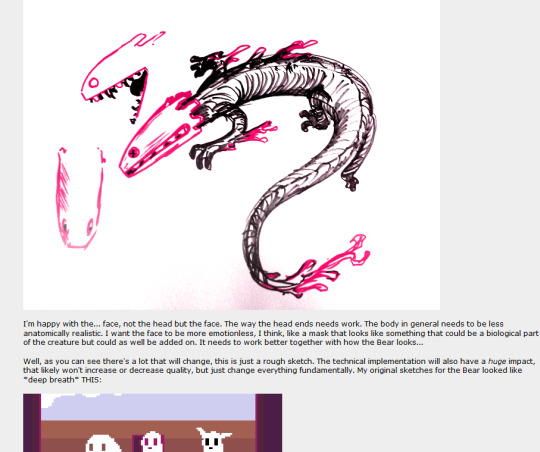
That said, the melty nature of the concept art shows a level of wild change inherent the biomechanical nature of the creatures, as if they truly are the result of these "tubes in boxes" almost revolting against their own boxes.
and considering centipedes... some tubes may not have had boxes in the first place!

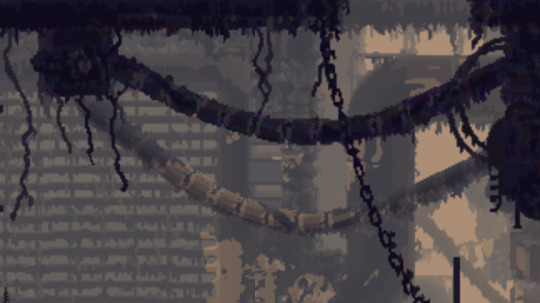

#rain world#rain world lore#rainworld#rw spoilers#please note! my role in downpour development does not make me an authority on what is canon or not!#my domain is entirely within challenge mode and arena which aren't canon anyway#my lore analysis is just lore analysis with no looks behind the scenes of anything vanilla#downpour was made as a fan expansion and the rewrites were just done directly by james#we didn't get any disambiguation on the lore (and thank fuck for that honestly. analysis is the best part)#though the hills ARE made of bricks#this is canon not because i say so but because it is visibly true in some areas of the game. part of the text and thus canon. weep.#i could go into more detail on most of this! purposed organisms aren't my area of expertise tho so i might be a bit shaky on some of that#anyway if anyone has any fact checking to do. please do so#media analysis is a dialogue!
442 notes
·
View notes
Text
Ink!Sans Cultural Character Coding (OUTDATED)
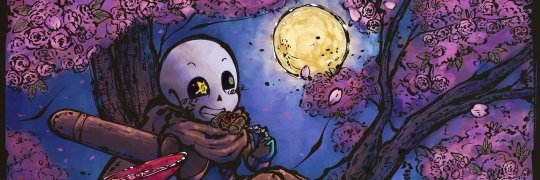
art by @/sakuramochi64 on twitter
Disclaimer!
This post is meant to present and analyse obvious and obscure East Asian (Jpn-Chi) ethnic and cultural influences on Ink!Sans character. If any of the material in this essay is incorrect and/or considered morally offensive, please contact me!
Ink!Sans by @comyet
↓↓↓↓↓↓↓↓↓↓↓↓↓↓↓↓↓↓↓↓↓↓↓↓↓↓↓↓↓
/Despite the fact that Ink is a non-human monster skeleton character, he is often portrayed with human-like traits and characteristics that range between a bunch of topics. One of them that's portrayed as very predominat to his character is his etchnic cultural background/inspiration. Again, this post is meant to analyse and to discuss such inspirations and how it affects his character./
.
.
.
INSPIRATIONS
According to Ink's creator, Comyet, the concept of Ink!Sans was conceived by a Japanese and Chinese ink calligraphy brush. These are known as Fude brushes (筆) and Xuan brushes (宣笔 Xuān bǐ) respectively. This ultimately inspired his ink abilities and powers, just like his concept of being an 'artist' (In simple words, it inspired Ink as a whole).
'The history of ink brushes and the ink material is a long and complicated journey to cover, but it's important to know that these were invented in ancient China around 300 B.C (traditional Chinese: 毛筆; simplified Chinese: 毛笔; pinyin: máo bǐ) and are used in a vast variety of East and Southeast Asian countries, like Korea; Vietnam and Japan.
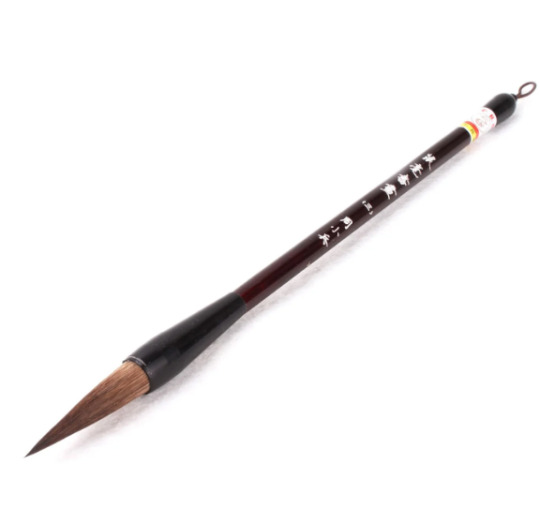
example of the brush Ink!Sans was inspired by.
At glance, ink (the material) is an enduring medium that still surrounds society till this day and it's used in multiple cultures across the world.
Writing with ink calligraphy brushes are common in the Europe and the Middle East as well, but the material was crafted of iron salt and oak galls. When written, ink is often a dark color but fades to brown tones of rust'. Such phenomenon was detectable in the Middle Eastern Bible manuscripts and even ancient European literature as an example.
Ink!Sans was based of the ink material created in East Asia, most commonly made with carbon-base black substance, which preserverd the dark coloration even after hundred of years.
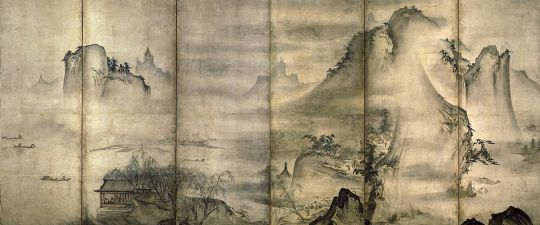
↑ Example of an ancient Japanese painting, such arts are called 'Sumi-e' (Japanese, 墨絵) or ' Shuimohua' (traditional Chinese,水墨畫).
Unlike iron gall ink, carbon based inks are still very common to this day.
'Throughout the long history of East Asia, writing with ink was a very important ability to have. The Materials were made with precision, long traditions of training in calligraphic skills were developed, and writing and literacy were often wrapped up in questions of social status and class.
Although the development of major Chinese calligraphic scripts was completed by the fourth century, the art of calligraphy continued to evolve over the millennia. Master calligraphers with years of training and dedicated practice were recognized for their personal styles, and later generations of artists often adapted brushstrokes and designs to their own style. This stylistic evolution of scripts continues to enliven Chinese calligraphy to the present day.
Calligraphy was an important mark of personal learning and aesthetic sensibility in Japan. Portable, lacquered wood boxes were designed to hold an inkstone and water dropper in the base, with trays to hold writing brushes and solid ink sticks. Inkstone boxes (硯箱,suzuribako 'ink stone box' ) could be easily carried to a pleasant location, even outdoors in fine weather, to write correspondence, diary entries, or poetry.'
Fun fact: Ink's font 'Note This' is inspired by such ancient writing.

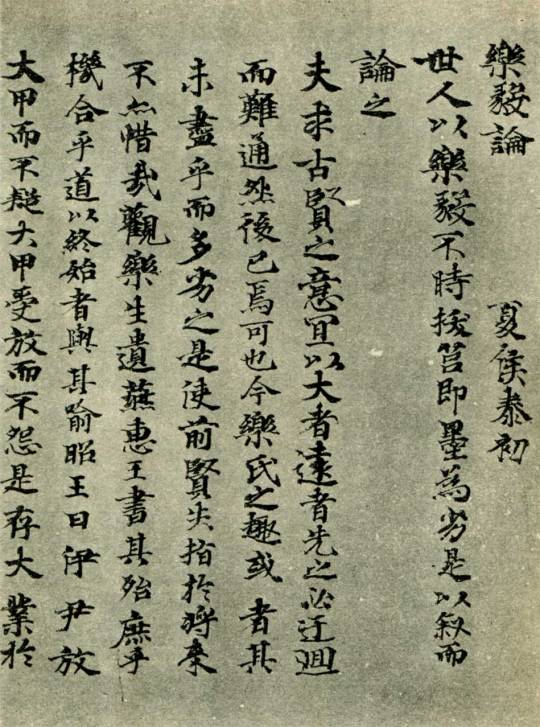
Example of Ink's canon speaking font and Japanese calligraphy (書道, calligraphy)
'However, when it comes to the subject of painting with the material, different schools of painting existed in China, the scholar-painters of Song-dynasty China generally preferred ink-based paintings over the more colorful, pigment-filled paintings produced historically and at the painting academy. Chinese painting manuals and commentaries from the Song (Sung) and Yuan dynasties (rarely mention pigments, possibly because it was assumed a painter’s skill shouldn’t depend on the use of colors.
Japanese artists are known for using media appropriate for the subject matter. Images depicting traditional Japanese narrative tales were typically rendered in opaque colors with outlines created in ink and later obscured by color overlay. Ink monochrome was closely associated with Chinese styles, particularly those transported to Japan via Zen Buddhism. Ink-based forms created with modulated strokes and layered washes suggested introspection and spiritual exploration.'

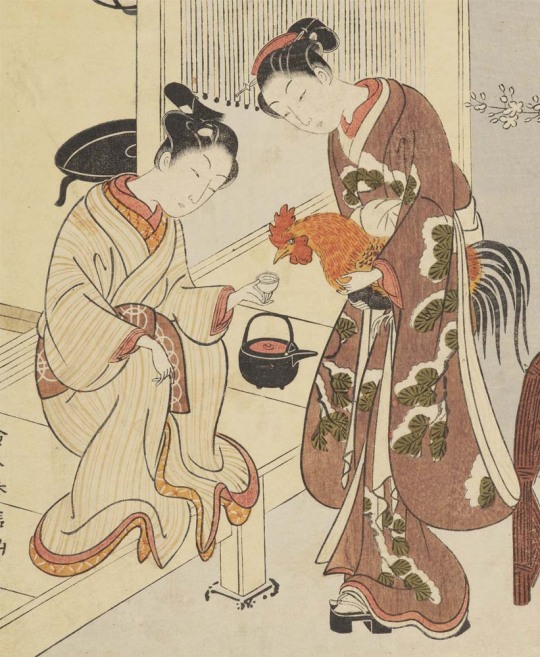
Ancient Japanese paintings that uses dull colors and ink outlines.
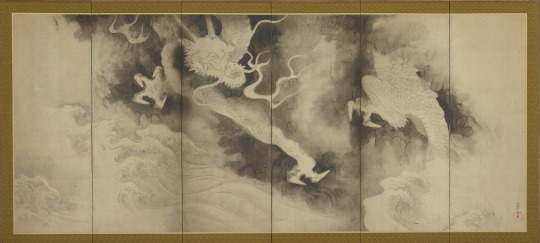
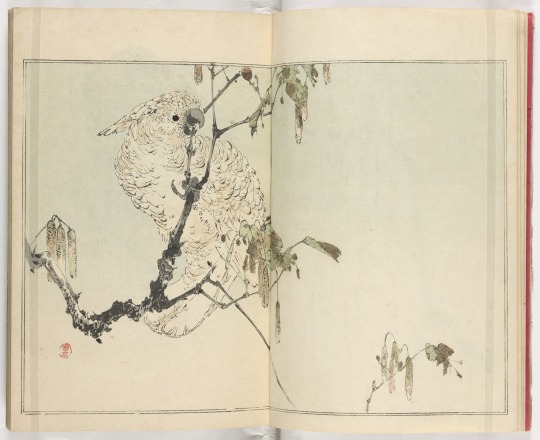
Exhaustive examples of ancient Ink paintings. Dragons and Clouds 雲龍図屏風 (左隻)and Seitei kachō gafu 省亭花鳥画譜
.
.
.
DESIGN
Also clarified in an ask on her main blog, Comyet describes that traditional Japanese clothing inspired Ink's 2020 outift redesing, such inspirations are very obvious in first and second analysis.
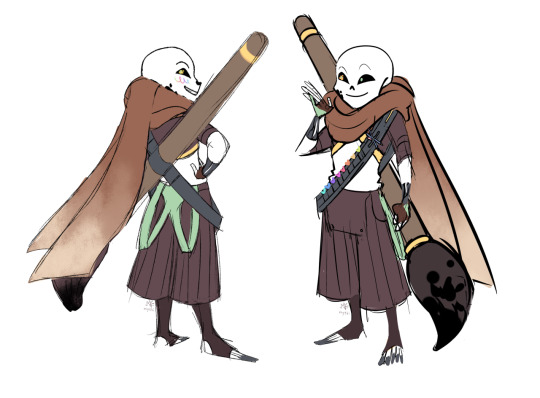
Ink!sans reference sheets for the 2020 design, which can be found in Ink's official F.A.Q
Starting off, the pants.
Ink's pants were inspired by Hakama pants (袴), a traditional Japanese garment designed as a skirt-like pants often worn over any type of kimono. His pants seems to be inspired by umanori (馬乗り)Hakamas, whose had a division in the middle and often used in horse-riding activities.

Example of a Hakama.
The Hakama is a wide pleated pants (seven pleats, five in front and two behind), with a rigid backrest (腰 板,koshi ita) placed at the level of the lumbar region. It is tightened with four straps, on the left and on the right, as well in front as behind.
Historically, the origins of the Hakama dates back to the Sui and Tan dynasty were this garment was worn by the Chinese imperial court. Later, the Hakama exported itself to Japan during the Kamakura period (1185 to 1332) and became a traditional garment for the upper classes of Japanese society as well as for samurai warriors who wore it over a kimono (Hakama-shita).
During the history of Japan, the Hakama took on different styles and was mainly made for men, although in the beginning it was a unisex garment. During the Asuka and Nara era (6th to 8th century), the Hakama came in two versions. The first one was open on the front and was tied on each side of the waist with two straps. The second one was open on the left side and closed on one side only.
During the Edo period, the Hakama was worn by the nobles as a complement to the outfits of the time such as the noshi and the kariginu (狩衣; a sleeveless jacket with very pronounced shoulders). Very functional, these pants were also adopted by samurai warriors who usually wore them as Kamishimo (上下/裃). It is a combination of kimono, Hakama and kataginu. When the warrior visited the shōgun, he wore a Hakama called naga-bakama which greatly restricted his movements.
Edit:Currently, hakamas are both worn by men and women.
However, under the scarft, Ink also seems to use a jacket that features a collar that has striking similarities to a Mandarin collar (or Mao collar)

Ink!sans reference sheets for the 2020 design, which can be found in Ink's official F.A.Q
Mandarin collars originated in ancient China and were worn by Qing-era bureaucrats.
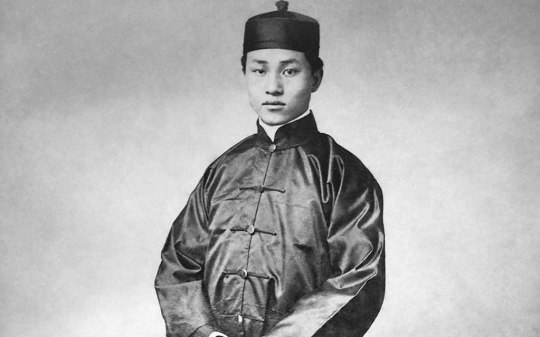
Picture of a Chinese man in a traditional Mandarin collar (early 1900's)
These are short, stand-up collars and sometimes fasten in the center with a small hook. Such collars are still used today for both fashionable and practical reasons. One example of modern usaged of the clothing is seen in the U.S Amry combat uniform, that features a stand-up collar of Chinese origin.

Picture of the U.S Army combat clothing
Regarding of color palette, Ink!Sans redesign uses soft but dull colors and a sinple silhouette and fabric for the outift, such design choises are similar to male kimono's dressing codes which uses dull colors (like dark blue, grey, green and occasionaly brown). Male kimonos are always more simple in design compared to female kimonos.

Photo that shows the difference of kimonos used by men and women
Although not specified, Ink seems to wear brown thigh-high socks, also known as 'tights' under the outfit. Japan has a long-standing cultural tradition of wearing such piece of clothing, this trend is particularly popular among young people and is often associated with the "gyaru" subculture, which emphasizes fashion, beauty, and individuality. Additionally, thigh-high socks are often worn with school uniforms, and are considered a symbol of youth and innocence. Additionally, it is also considered fashionable and trendy in Japan, and you can see many young people wearing them.
In regards of physical appearance, Ink also seems to follow ancient Japanese and Chinese beauty standarts, specially one's targeted towards women.
In ancient japan, specially towards the Nara (奈良時代, Nara jidai), Heian (平安時代, Heian jidai) and Edo period (江戸時代, Edo jidai) the beauty standarts for Japanese women were of those with slim eyebrowns, flat oval face shape and narrowed eyes.
Such attributes can be observed on Ink!Sans apperance.
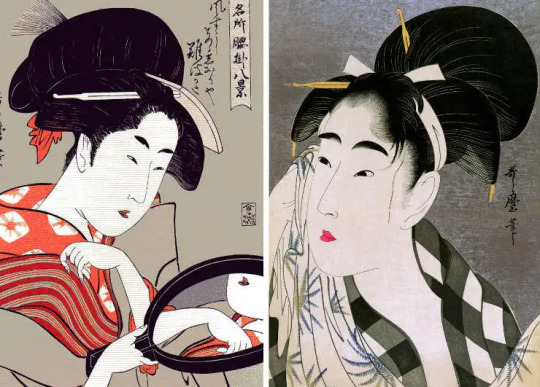
Visual representation of old Japanese beauty standarts
/Keep in mind that some of such standarts presented are now out of fashion due to the westernization of asian countries. Specially regarding eye shape/
.
.
.
MUSICAL THEMES
Ink!Sans has a long history of being associated with East Asian music, specially those of Japanese origin.
Themes that comyet associated with him includes, 'Code Wu- Asia River Album 江水/Asia River' ( post can be found here), 'Dullahan under the willows' and 'Futatsuiwa from Sado (二ツ岩で佐渡) both from the japanese game 'Touhou'. (post can also be found here.
He's also associated with East Asian musical instruments, something quite noticeable in Ink!Sans theme for the the web-series 'Underverse'. Such theme is called 'Brushwork'.
The theme starts with an instrument similar to a Shamisen (Japanese-三味線) and a Guzhen (Chinese-古筝) and also uses a traditional flute.
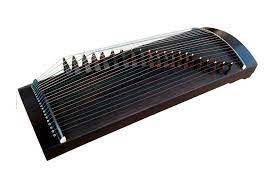
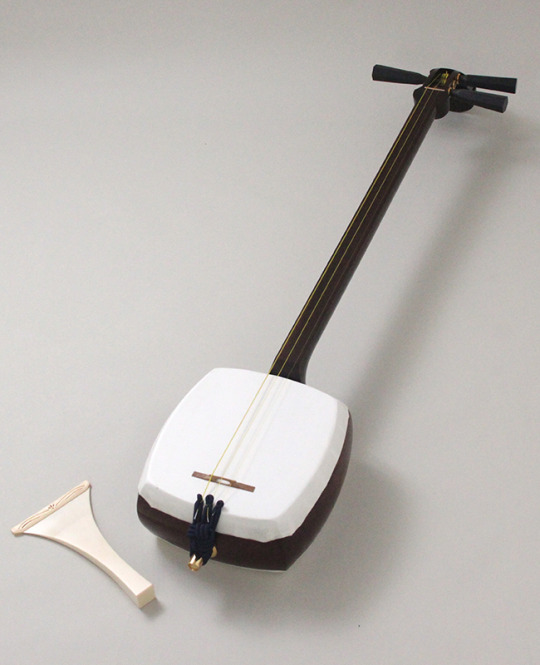
Photo of a Guzhen and a Shamisen, respectively
.
.
.
TRIVIA
On Underverse's opening for season 2, Ink!Sans can be seem between a field of Sakura trees or Cherry Blossoms (桜).
Cherry blossom trees are an icon of Japan. Some people even call the cherry blossom Japan’s informal national flower. The Japanese school year starts in April, during cherry blossom season. The flowers symbolize good luck, love, and springtime. Since they bloom for such a short time, cherry blossom trees also represent human mortality. They remind us how short and precious life is.
In the same series, Ink is also drawn in a Sumi-e inspired style for the 'Soulless Heart Instrumental' video. Such artwork features Japanese writing in black ink.
Ink's canon instrument is the flute. Although invented in ancient germany, the flute is highly associated with East Asian cultures and it's music, chinese and japanese culture are the main ones . Other than that, Comyet already made a connection to Ink's asian influence and the instrument itself.
According to research made by the University Microfilms International (UMI) affirms that the moderny performance and melody of the instruments has clear East Asian roots, mainly from Chinese and Japanese style of music.
'The flute is a particularly appropriate instrument for such a
study because of its versatility of pitch and timbre, the latter being
one of the most important elements in Eastern music; it is capable of
'pitch-bending' and infinite changes in tone quality which are impossible
to achieve on instruments of set pitch.
The flute music selected for stud/ shows varying degrees of Eastern
influence. Depending on the nature of the composition, the Eastern
elements may be extremely subtle and difficult for the untrained to
decipher; in other instances the composer makes clear those sounds or
concepts with Eastern roots, either through accompanying explanation or
within the context of the music.'
Sources
1.National Museum of asian art (materials & techniques. Ink section)
2. Asian Brushpaper (an-overview-of-chinese-ink-history)
3. Wikipedia (wiki Hakama-pants)
4. Aikido Journal (Hakama-101)
5. Wikipedia (Mandarin-collar)
6. Kirrin finch (What-is-a-mandarin-collar)
7. University Microfilms International (UMI) (east-asian-presence-in-modern-flute-music)
#ink sans#inktale#undertaleau#utmv au#ink!sans#utmv#inksans#undertale#east asian#au sans#sans au#cultural inspiration
435 notes
·
View notes
Text
A fascinating thing that legends and myths do that a lot of modern stories don’t is follow a hero until the stupid and bitter very preventable end. People want to know how culture heroes died. Superman never stays permanently dead. A lot of modern heroes either can’t stay dead or die somewhere offscreen. Or if they don’t die offscreen nobody trusts that they’re actually dead because of the frustrating precedent that heroes don’t stay dead.
Mythological heroes have death stories. They burn alive or tie themselves to standing stones while they bleed out or get crushed by a rotting ship or get bitten in half or or get killed by a magic box or are still waiting asleep somewhere. They die and they die stupidly and tragically and they either stay dead or become immortal. Solid end. Done. Gone out of the narrative one way or another. Modern superhero media refuses to let their heroes get killed by giant scorpions. This is why I read books from ancient times.
528 notes
·
View notes
Text
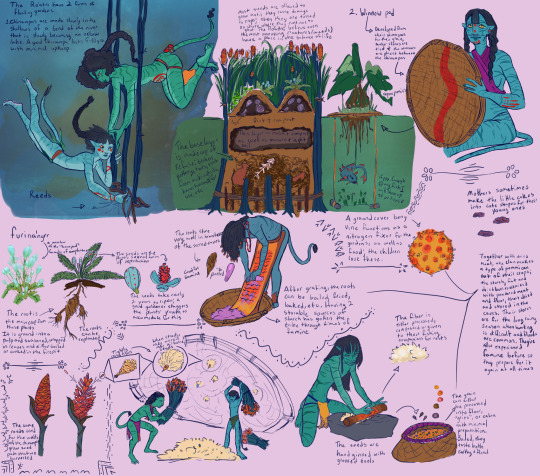
ok so this was a beast to draw and research good GORD. this one requires a glossary so i'll be putting the entire text under a read more bar, meet me there?
I think most of us in the Avatar fandom have some range of obscure knowledge (or who knows maybe the knowledge is less obscure to everyone else and I'm the silly one) but here's a handful of words I had to learn for this: Chinampa: small, stationary, artificial island built on a freshwater lake for agricultural purposes. Chinampan was the ancient name for the southwestern region of the Valley of Mexico, the region of Xochimilco, and it was there that the technique was—and is still—most widely used. (Encyclopedia Britannica)
Conuco: A portion of earth that the native Tainos of the Caribbean would grow their crops on. (More on that later)
Winnow: In the western world, to remove (something, such as chaff) by a current of air. I specifically based theirs off of a video that @aketchjoywinnie on tiktok posted of her culture's winnows. She is from Uganda and I love her videos whenever they come across my fyp. In this case it is more of a woven basket/plate that is used for food.
As for the drawing:
The Ro'atni have 2 forms of 'floating' gardens. The first and most productive are their chinampas; kind of important to the context is that the Ro'atni were originally a river people, but a portion of their river gave way to an oxbow lake. The young lake has turned into their gardens. The chinampas are made by their swimmers who usually chose their lifestyle very young, as their bodies adjust and grow to adapt underwater better; their strakes go from soft, unobtrusive cartilage to actual strakes, smaller than the reef people's. They dive under water and plant the reedy plants that they then weave together into a roughly rectangular box. Each chinampa is a labor of love that normally takes years to make (though if they feel the next season will not be fruitful they can and will build some quickly). The base layer of the chinampas is essentially a refuse pile. Their compost, their unusable bones, any trash (which is much less than most modern societies) is thrown into the woven reed "basket" to form the solid base along with base stones. The middle layer, still submerged in water, is a combination of compost, mulch, manure, night soil and gravel.
As the compost decomposes, they churn the dirt and build it up over the years until they build above the water level; once the dirt remains relatively dry on a sunny day, and they can dig without immediately hitting mud, they begin to build the conucos on top of the chinampas.
The Conucos are logs stacked up and packed with earth, the shape keeps plants that need dryer soil out of the water, and retains water when the lake starts drying down during the dry season. As the logs decompose they leave behind air pockets for the roots to take up as well as the necessary microorganisms. Most of the weeds are allowed to grow to an extent - once they begin to choke out the plants they want, they will be cut down. The Ro'atni believe that even the most annoying creatures (weeds) have a place in the balance of life. If they're uprooted, they're tossed on shore where they continue to grow. To combat the growth of weeds, they plant a groundcover berry-producing vine that functions as a nitrogen fixer as well as food.
The second form of floating gardens tend to be used for children to learn, as they operate on the principles of aquaponics. The winnow pads are sometimes made specifically for the purpose, but often they're made from a winnow that has reached the end of its life. If it is no longer buoyant, it is tossed into the bottom of a new chinampa. If it is buoyant, then small anchors are tied to the bottom, and a fast growing plant is placed on the winnow to take advantage of the nutrition in the water. Often seedlings for the chinampas are grown this way and transplanted once they're big enough.
Now for the plants they grow; I only had the mental bandwidth to name ONE plant, and I welcome any professional Na'vi speakers to correct me on it lol. So, they grow: Furina'ngrr: Primarily this plant functions as a starchy tuber, but it also grows "beans" (in the way that a coffee bean is a bean but its actually a berry) with a soft outer fruit that the entire clan uses to produce a bright red stain/dye. Combined with red ochre and animal fat, it creates a thick, water resistant body paint that they use both to ward off bugs and to paint pretty patterns and symbols on their skin; certain ones are protective symbols. The fruit can be peeled off of the bean and the beans can be eaten; they're more often replanted to avoid genetic monocropping. They only ripen every 2 years more or less, so the elder gardeners know to stagger their crop growth to accommodate for it. The root however is the main crop from these plants. It is ground into a pulp, seasoned and wrapped in leaves, then either boiled or cooked in a firepit. It's dumpling-like in the firepit, and more like a mochi if its boiled. It can also be fried and baked depending on preparation. The roots can be replanted and this is the quickest way to propagate the plant. They also store for a long time in a root cellar like environment. This is their first source of starch.
Reed-maize: Many different kinds of reeds can be used to create chinampas, but reed-maize is the favored choice; even after their cultivation the reeds remain for a good while before decomposing, giving the gardeners time to grow their replacements, replant them around the chinampas and weave them in again. The reed-maize grow seed pods that can be harvested; they usually require a good strike to release their seeds, which is an adaptation to release their seeds during windy season when the fluffy seeds can fly far away. These were a gift from the Sa'anre side of the clan, and comes originally from the swamps and deltas they traverse; in the oxbow lake the wind is only strong enough during typhoon-like weather to open the seedpods. The seeds release from the pods wrapped in tightly coiled fibers that spring open as they fly out; the fibers carry them on the wind. So the gardeners beat the seed pods open only inside of the hometree or where large structures have been built to catch them. The fibers are hand-ginned off of the seeds, and the seeds are then winnowed free of chaff. The fiber can be processed into cloth, but its very time consuming so they often trade it out to other clans. Other uses are compost mulch, or bedding for their fishing companions. The seeds range in color from soft oranges to gray-blues; an act of love is to separate the specific color seed your child/mate/parent loves most and to make them ground cakes from the singular color. It's extremely time intensive to sort, then grind these seeds separate from all the rest. Normally however, they are stored as grain alongside the furina'ngrr. The grain can then either be processed into flour, "grits", or eaten with minimal preparation. Boiled, they taste both earthy and floral.
Oh my gosh almost done guys lets go. Together with dried and powdered meat, the clan makes a type of pemmican out of their crops; dried roots, dried meat, dried berries and fat are mixed with reed-maize flour, then dried down and stored in their root cellar caves. Their stores are for the long rainy season when hunting is difficult and flooding is common. They have also experienced famine before so they prepare for it again at all times.
Mothers sometimes make the little pemmican cakes into cute shapes for their young ones!
#oh my god thats a mini wiki at this point#can you tell the brainworms got me#avatar 2009#avatar the way of water#avatar frontiers of pandora#avatar ocs#na'vi ocs#avatar fanart#avatar fanclan#na'vi fanclan
96 notes
·
View notes
Text
Reviving the Dormant Seed

Chapter 13: Lord Ragnivald's Game
In which Lich Lord Ragnivald plays a dirty hand and digs up an old wound for Emmrich…
Read the full chapter here
The first of which was the tablet, which he motioned towards Manfred for the Qunari to see. The translator, a rather squirrely looking fellow with shaved down horns, spoke quickly to who Emmrich assumed was their leader, though the rank and its name were lost to him, and while the sight of the tablet certainly piqued the translator’s interests, the leader’s expression remained as unspeakable as the stone the tablet was made out of. “A companion of mine back during 9.53 Dragon found this tablet in a dragon’s hoard in the Rivain coast. Their mother, Shathann, was an Ashkaari who specialized in ancient Qunari culture and provided her services to the Lords of Fortune when she took her child and left to live in Rivaine. She believed this tablet to have been from the Steel Age and eventually discovered that its message-”
“Could be revealed with dragon fire,” the translator said, cutting off not only the professor but his own leader, as the way he held his hand up was to keep another from speaking up. Probably for the best, as Emmrich noticed the leader’s growing impatience the longer he spoke but wasn’t entirely sure of its cause. “That is why we are here, Ashkaari Volkarin. We are here for the Adaari you once knew as Evataash and nothing more.”
Nothing could have taken the wind out of his sails faster than hearing that name uttered, and given the way the translator’s expression shifted from forced polite to genuine confusion, then concern, he knew he did a terrible job in hiding it. “I take it they did not inform you prior to this meeting?”
By ‘they, he knew he meant the other Lich lords. Lord Ragnivald in particular, as he was quick to expose his involvement as one had to be deaf not to hear the blood-curling smugness in that voice of his. “I’m afraid Young Volkarin was too preoccupied in his own personal affairs to have read any of the correspondence we’ve set his way prior to the meeting. Had he done so, he would’ve known not to waste our time with such a self-indulgent display.”
Manfred was the first to whisper to him, no doubt still feeling guilty regarding the pineapple fiasco. “I checked the letter box and the scrying table, Professor. There were no such correspondences!”
“It might’ve gotten delayed,” Ash said, though it was clear she wasn’t throwing the blame onto Manfred, or anyone else in the Volkarin household. She forced her gaze downwards, towards the ambassadors, because if she looked up and saw Ragnivald’s sneering grin, she wasn’t sure she’d maintain her composure. “No doubt it’ll be waiting for us the moment we return to the apartment.”
Admittedly, Emmrich wasn’t thinking too hard about it. It was easy for such letters to get lost or held up, especially if the Necropolis was feeling exceptionally moody or the spirits didn’t feel inclined to be helpful to a certain individual. There were also other methods of relaying messages, from one Lich lord to the other, methods that Emmrich couldn’t have possibly ignored, with or without the distractions he had been drowning in as of late. The fact that he had received such a warning was intentional, and yet, without proof or without dragging this meeting out and pulling others into it, he had no way of addressing such grievances with Lord Ragnivald.
At best, he looked like a fool for coming prepared for a presentation that wasn’t needed. At worst, he’d have to…
Clover and Thistle, ever near his side, kept him grounded in their own way. Clover with her warm tongue to his hand and Thistle’s weight to his leg, though Emmrich had to fight against the urge to sit. He couldn’t afford to take a seat, not now, anyways. Not when there were people demanding his attention, as the Qunari leader growled out his words and the translator chiming in immediately afterwards. “It is no concern of ours what game you play with your own, Lord Ragnivald. We are here for Evataash’s assistance and we have no plans on leaving without either her or a reasonable substitution.”
“Then you will have to do with a reasonable substitution, for they are unable to assist you,” Emmrich said, genuinely surprised at how calm he sounded despite the ball forming in the pit where his stomach used to be. “They’ve long since past on, and-”
The translator raised a hand to his leader, holding off his own translation, as he addressed Emmrich personally. “We are aware, however, we are told that Nevarra is renown for its necromancy, which would negate any problems regarding their current status.”
“You want me to-” Emmrich couldn’t say the word. He couldn’t even think the word, not without feeling the world start to spin beneath his feet. He felt Clover’s weight, heard her whine, but he couldn’t respond to it in kind. Not when someone was asking him, no, expecting him to do the unthinkable. “What you are asking me to do is something that cannot be done.”
He knew this wouldn’t please either the ambassadors or the translators. He could tell the Rivani seers, who understood every word he was saying, weren’t pleased, but they also seemed curious to why a necromancer would be so adamantly against the idea of performing the magic their entire nation seemed to be known for to the rest of Thedas. Were they in a different environment or the situation not so dire, he’d have explained all the many reasons why it wasn’t as simple as they’d think it to be, or why Emmrich, specifically, was against the idea, but he didn’t have that luxury. None of them did.
"And, pray tell, Young Volkarin, why can’t it be done?” When the Qunari started to raise their voices in obvious objection, Lord Ragnivald’s ever domineering voice rang out, silencing them and unknowingly aiding Emmrich in keeping him tethered to the present, though that’d be short lived. The way he addressed Emmrich, the words he chose, made it abundantly clear what his intentions were this day, and by the time Emmrich or those in his company realized it, it was too late. “Explain to everyone in attendance why this Evataash cannot be resurrected.”
#dragon age the veilguard#dragon age veilguard#emmrich volkarin#dragon age fanfiction#da4 fanfic#dav fanfic#emmrich x rook#emmrook
7 notes
·
View notes
Text
To kick off this blog I wanted to create a post about my favorite Mesoamerican Artifact. “The Shaman in Transformation Pose” Culture: Olmec 800 B.C. in polished gray stone. Discovered in Teopantecuanitlan, current day Guerrero.

Something that truly stands out on the first figure is the carving of a smiling toad on its forehead, which Scholars (such as the ones in the source listed below) believe could be the cane toad (Rhinella marina) formerly assigned to the genus Bufo.

But now who is this very inquisitive gentleman? The cane toad is a frog that would have induced hallucinations into the ancient olmecs and although some scholars believe that this motif displays the shaman transforming into a frog i am more inclined to agree with Dr Reilly, that this motif is merely a symbol for transformation.

The second artifact i wanna discuss is the Hauberg-Dumbarton Oaks kneeling were-jaguar, Culture: Olmec. Serpentine, with traces of red cinnabar. When these artifacts are placed together (along with their four other brothers) a story takes shape in the form of a shaman's transformation into a jaguar. These figures would have at one point been covered in red cinnabar indicating their importance.

As shown above we see this transformation take place with the final form being the standing jaguar statue (or as a i like to call it, the boxing jaguar or jaguar dancing the salsa) The importance of these artifacts is that they not only provide us with a valuable insight into Olmec artistic cannon but they also as Dr Reilly states show that “The traces of red cinnabar signify that if the figures were not created as grave furniture, they were used in the funeral ritual and placed in the grave” (More on red cinnabar and its importance in mesoamerica in a later blog post). These figures would have at this time had been placed in graves of elite members of society and could have backed up the hypothesis of michael coe in his work "Olmec Jaguars and Olmec Kings” And later restated in Dr Reillys article that olmec theogny would have been used to confirm royal power.
Sources
Reilly, F. Kent. “The Shaman in Transformation Pose: A Study of the Theme of Rulership in Olmec Art.” Record of the Art Museum, Princeton University, vol. 48, no. 2, 1989, pp. 5–21. JSTOR, https://doi.org/10.2307/3774730. Accessed 3 Dec. 2024.
Michael D. Coe, "Olmec Jaguars and Olmec Kings,"
8 notes
·
View notes
Text
Hexafoil | daisy wheel, witch marks, rosette | apotropaic mark This symbol was used to protect one from harm, evil, malefic magic, and bad luck. It was carved into wood or stone in buildings (often places of worship), graves, or other objects or items.

Limestone ossuary from Jerusalem, ROM
A geometric design "with six-fold dihedral symmetry composed from six vesica piscis lenses arranged radially around a central point, often shown enclosed in a circumference of another six lenses."
As with many symbols ancient, this one cannot be accurately ascribed to any single people, religion, or culture. Those who have studied it's origins have proposed overlapping theories about the symbol being a solar symbol, or a storm symbol. Each attributing the origin to various gods (Taranis, Perkwunos, Perun, Tarhunz, Thor, Jupiter...) or delving into the name of the symbol across many languages ('little sun', 'sun of the Alps', 'thunder sign', 'thunder wheel') without definitive conclusion.
While some have tried to claim the symbol of Christian origin, hexfoils have been discovered on several Jewish ossuary boxes (dating around 100 BCE- 100 CE) and it was suggested that the symbol was borrowed from earlier pagans.
When looking into what tool would have been used to craft the geometric image left behind (difficult/near impossible to do by hand) it was suggested that either dividers, sheep sheers, or race knives could have been used.
Dividers were less accessible as they were tools primarily used by masons, which has been recorded throughout history in various artworks. Alternatively it was suggested that common people would have had access to sheers (sheep) which were a common enough tool for farmers. The race knife is still used today by carpenters, however most would not have been the appropriate size for large hexfoils found carved into beams and boards.
To Read: Daisy Wheel, Hexfoil, Hexafoil, Rosette: Protective Marks in Gravestone Art - Robyn S. Lacy
Goodenough, Erwin R. 1957. The Study of Man: Pagan Symbols in Jewish Antiquity. Commentary
6 notes
·
View notes
Text

3,200-Year-Old Egyptian Tomb of Ramesses III’s Military Commander Uncovered
Egyptian archaeologists have discovered a 3,200-year-old tomb thought to be that of a senior military commander during the time of Pharaoh Ramesses III. The tomb was discovered at the Tell el-Maschuta site, also referred to as Tell el-Maskhuta, in the Ismailia governorate. The discovery illuminates the strategic significance of the area in protecting Egypt’s eastern borders during the New Kingdom period.
Dr. Mohamed Ismail Khaled, Supreme Council of Antiquities Secretary General, underlined the significance of the discovery, noting that the Tell el-Maschuta area was a key military outpost. Existing fortifications and garrisons in the region suggest that it played a crucial role in defending Egypt against external threats.
The tomb, constructed using mud bricks, features a main burial chamber and three other surrounding rooms whose walls are covered with white mortar. Inside, archaeologists discovered a collection of artifacts that indicate the deceased was a high-ranking military official. The most significant items discovered were a gold ring with the cartouche of Ramesses III, bronze arrowheads, and a small ivory box. The artifacts suggest the individual was the pharaoh’s military leader.



One of the most fascinating finds was a set of inscribed pottery vessels with the name of Pharaoh Horemheb, who reigned from around 1323 to 1295 BCE. A former military leader before becoming a pharaoh, Horemheb ruled over a hundred years prior to Ramesses III. The fact that his name appears on the pottery indicates that the tomb could have been reused over time.
Further evidence of the reuse of the tomb came to light through the human remains recovered inside. A skeleton covered in cartonnage—material made up of linen and plaster—refers to the fact that the burial had been altered in later periods. In addition to skeletal remains, archaeologists also recovered alabaster vessels, semi-precious stones, and amulets depicting the gods Taweret and Bes, as well as the Eye of Udjat, a protective symbol in Egyptian mythology.
Beyond the military commander’s tomb, archaeologists also uncovered a series of collective and individual burials dating to the Greco-Roman and Late Periods. These burials contained skeletal remains and funerary artifacts that highlight the region’s rich cultural history as a crossroads between civilizations. Professor Qutb Fawzi Qutb, director of the Lower Egypt and Sinai Antiquities Department, noted that the combination of Egyptian and Greco-Roman elements in the tombs provides valuable insights into the region’s diverse historical influences.



In addition to the tomb of the military commander, archaeologists also unearthed a series of collective and individual burials that dated to both the Greco-Roman and the Late Period. The burials contained skeletal remains and artifacts revealing the region’s rich cultural history as a crossroads between civilizations.
Ramesses III, who ruled from about 1184 to 1153 BCE during Egypt’s 20th Dynasty, is often regarded as the last great pharaoh of ancient Egypt. His reign was marked by military conflicts, most notably his conflicts with the Sea Peoples, a group of seafaring raiders that threatened the stability of Mediterranean civilizations. In the most pivotal battle, the Battle of the Delta in 1175 BCE, the Egyptian navy outmaneuvered the invaders with tactical superiority on the waterways of the Nile.
The recently discovered tomb brings intriguing speculations about the occupant’s role in these wars of antiquity. If this individual buried within was a military commander under Ramesses III, he may have played a crucial role in defending Egypt.
The Egyptian Tourism and Antiquities Ministry stated it would go ahead with more excavations and studies on the site in the hopes that further studies will reveal additional information on Egypt’s military and cultural history.
By Dario Radley.

#3200-Year-Old Egyptian Tomb of Ramesses III’s Military Commander Uncovered#Tell el-Maschuta#Tell el-Maskhuta#Pharaoh Ramesses III#ancient graves#ancient tombs#funeral goods#grave goods#ancient artifacts#archeology#history#history news#ancient history#ancient culture#ancient civilizations#ancient egypt#egyptian history
25 notes
·
View notes
Text
A few thoughts I would like to share.
I'm sharing this because the spirits and gods have been serving me with this wisdom. I hope it's beneficial for you as well.
There is a misconception floating around that the older a spiritual practice is (or can be found on record), the more valid it is. For those of us in the modern age who are inundated with messages from Witchtok (urgh) or random corners of the internet saying that our practices are invalid because it's not historically accurate... here is some food for thought.
For a lot of faiths and traditions (such as a Nordic tradition), there is not a lot of information to go on. Many traditions have, unfortunately, been lost due to acculturation and assimilation over time. I am grateful for the information we do have and is able to be preserved through countless centuries of scholarly work that continues into today. However, we are forced to fill in the gaps in order to continue on for the sake of tradition, preserving the memory of our ancestors, and just because. You don't need a reason to follow a faith you are called to. That's why it's called faith.
There is a lot of misinformation floating around regarding certain practices that do not line up with the historical record. I believe this is happening because there is a weird grievance to justify our faith and everything that we do by making it look like our ancestors have been doing the same things for centuries. In other words, our faith isn't valid in the eyes of others unless we can prove that it's an ancient, historical practice like the powerhouse religions of Christianity/Judaism/Islam or Vedism.
Well, I think that's stupid.
Faith, like humans, nature, and culture, are meant to evolve. It is meant to grow. It is meant to change with the seasons, with the people, with whatever the fuck is happening in the day and age. Things are not meant to look the same forever and ever. It just isn't feasible. And I am fully confident that old gods and vættir realize this. We can't help the fact that a lot of information has been lost. We are having to adapt, adopt, and craft something new to help us connect, and there is absolutely nothing wrong with that, my siblings.
The idea that every little thing you do for the sake of your faith, practice, or tradition has to be traced back to a historical record is, in my opinion, a trap crafted by the dominant cultures and religions to keep us in enclosed in boxes that we are not meant to settle in.
Now, with all that said, I do believe there are some very important keys from the historical record that should be upheld or, at least, be cross-referenced at some point for the sake of following a tradition that is set in stone. But, considering a lot of us are children of immigration and are no longer in the countries of our ancestors, there are some things that are impossible to follow. That's why we should be open to adapting, adopting, and evolving from where we are to craft new traditions. This was entirely normal and valid back in the day, so why can't it be now?
Remember the past, honor the past, but don't be afraid to take the information we do have and craft it into a faith or practice that suits you and/or your family. After all, someday we will be ancestors, and the practices you do today may be honored by your descendants decades or even centuries into the future. Isn't that neat? Or, if the bloodline ends with you, records of your practice may resonate with someone who is searching for pieces of their truth.
Allow the ancestors, vættir, nature, old gods, and most importantly, yourself to guide you. Everything else is just a means to an end.
TL;DR you are allowed to create something new from historical sources to express your faith. It's perfectly valid despite protests from ignorant people who have nothing better to do than start fights on the internet.

#pagan#norse#norse pagan#norse paganism#heathen#heathenry#paganism#paganblr#pagan worship#deity worship#the old ways#norse gods#norse mythology#norse heathen#norse polytheism#polytheism#spirituality#spiritual journey#spiritualgrowth
11 notes
·
View notes
Text
Everlasting Promise ~ Inspired by 'Corpse Puppet AU' by @sketchquill
There’s an old Celtic Blood Vow that goes beyond the simple promise of modern day vows. Coming from a place of deep love and eternal tie that bounds the two forever until death. Or much longer depending. Mavis always treasured those vows in her heart and yearned to find her true love and soulmate forever. It was silly and most of the time felt pointless, but it was a dream. The Gaelic translations are not quite word for word but this is what she remembered deep in her heart.
Ye are Blood of my Blood, and Bone of my Bone.I give ye my Body, that we Two might be One.I give ye my Spirit, 'til our Life shall be Done.
Wishing she could say these vows with all the love for her groom to be in her heart. Except she couldn’t bring herself to do so. Let alone was not allowed to even utter these vows. Too “barbaric” as her parents said. Her groom somehow thought the same. Not unkind or awful but just didn’t care so much for her. She wondered if he ever cared for things at all.
With a heavy heart she wandered the town and felt a melody of sorrows pour out from her soul. The cold stone pathways beneath her feet as she felt the rough stones make her entire body ache in pain with every step. Or perhaps it was because they reminded her of the dread to come. Across the bridge and towards the old church near the deep woods she found herself in the chapel.
Alone and only illuminated by the single lantern gripped in her fingers by the thin iron handle. Walked passed the pews as a waive of deja vu washed over her. A premonition of things to come for tomorrow. With a heavy sigh she looked ahead and noticed a box resting upon the alter. Stepping a bit quicker, set the lantern to the side and wiped away the dust of the old box. Marks and engravings of Scottish/Irish culture with Gaelic markings.
It was unlocked and something compelled her to look inside. Upon doing so the rays of the moonlight peaked through the windows and shined upon a silver dagger. One used for ancient blood vow rituals. A gasp escaped her lips. She knew the priest wasn’t into such things but perhaps he felt a bit of sympathy towards her. After all her family was cold and cruel to her ever since they were loosing their fortune. This marriage was only to save their pride from being out on the streets.
Her fingertips grazed the smooth coldness of the hilt and between the edges of the blade. Without even touching the tip just knew it was sharp. Ready to open up a part of her and her beloved for their life of scarlet to unite into one binding forever. Taking a deep breathe, felt the tears lining her eyes, her entire body shaking.
Lifting up her trembling hands. Slowly intied the string of her hooded cloak. Allowing it to slip to the floor, her brunette curls cascading down to her waist. Her off the shoulder and sweetheart neckline purple gown revealed too much skin per society standards. But it was enough. Enough to not bother making a tear in the fabric she wore. Although the stains would ruin it anyway. Less fighting back the force from piercing through to the skin. From the stitches.
Reaching out she grabbed the dagger in her quivering fingertips. Tears rolled down her cheeks slowly as her mouth parted open. Her breathing a bit shaken as she lifted up the slightly dense object in her palm. Turning it around slowly as the tip of the blade touched her skin, right above her heart. A small poke already caused a small drop of blood to trickle down her chest.
That’s when the world around her froze. Where she felt a moment to stop the shaking, regain a bit of control as she leaned back slightly. Raising the weapon that will end her suffering just a bit higher above her head. With one last look upon the full moon, one last bit of beauty, she faced the darkness. Shut her eyes and took a deep breath. Her final breath.
In one swift motion she began it aim it directly at her heart. Only she didn’t feel the sharp plunge beneath her skin. In fact she sensed its presence but hovering over her. Mocking her intention it felt. But there was another thing that caused her to open her eyes. Feeling two hands grasping her wrists from behind. Holding her between two arms that were quite strong. The familiar dressed black suit, a more blue felt color of skin poking through the torn sleeve on one side and the deep stitches all over. Looking ahead she saw one hand gripping her wrists, the other on the hit holding it back.
“Mavis….why…..?….”
Another gasp escaped her lips. The voice was…familiar…haunted even. But that couldn’t be? For he was long ago passed away. Into the plane of existence between realms. This had to be a dream. A hallucination. He wasn’t….there was no way this was real. But her heart pounded all the same. Just like when he was alive and by her side all those years ago.
“W-W-…Wally?” She breathed feeling all sorts of emotions, most a bit foolish for even asking.
“Yes… I’m here Mavis.”
The whisper in her ear caused the dagger to drop from her fingertips and a swift turn around to face whomever was behind her. The clink of metal upon the wooden floor and her eyes widening as the moonlight gleamed a bit brighter to illuminate them both. Lifting her hands upon seeing the face of someone she once knew. Albeit a bit more…corspely than before but that was to be expected. Well actually none of this was ever expected. Yet here he stood. In a torn up suit and flower crown veil. Looking upon her as he once always did.
“W-Wally….y-you’re-….”
“Yes” He responded as if he heard her thoughts. Perhaps he did, who would know when it came to the undead. Wally smiled and gazed upon Mavis with such adoration and a bit of worry from earlier.
“It seems we both have questions” He continued gently, not wanting to scare her off.
“Just like when we were kids. One question each. I know it’s…frightening to see me like this. But I will tell you I promise.”
His words came out slow and soft. Mavis just stood there in utter bewilderment. If anyone else was in this situation their gut would tell them to run away and never look back. But Mavis, she felt something different inside her. Something that compelled her to stay and listen. After all the other side to this coin of an opportunity was that her friend was here. Her dearest friend whom she cared for deeply. Whatever time she had now would need to be cherished forever. With a small hesitant nod and smile, stayed in place.
“O-okay” Mavis stuttered slightly, waiting for him to ask since she already sort of did earlier. Wally’s smile faltered and pointed down at the dagger laying between them. Her drop of blood still evident upon the tip. Not once did he look away from her whilst asking his trouble question.
“Why? Why were you about to-….”
“I- I don’t know what fully compelled me to do so in that moment. But after everything I’ve been through…. it felt like my only escape.” Biting her lower lip to hold back the tears and her trembling voice that dared to threaten this moment. Swallowing a deep breath and back her own sorrows before smiling again.
“How are you here? I thought…this seems impossible.”
“I thought so as well” Wally began. Knowing he had more to ask about her but kept his promise to be fair in all this.
“There is a place between above and below called the Land of the Dead. I was also pledged to be married to someone…who ended up killing me as you might’ve heard at some point.” He paused as she nodded with a bit of anger and sorrow in her eyes. “There I wandered aimlessly trying to familiarize my current surroundings. Whilst searching for a way to find closure in my unfinished business here in the living world.
I came across some rather strange trees with doorways that marked different paths of seasons and realms. Finding a few friends I found myself a place to rest. However I knew there was something I had to do here. I was compelled to come through the door of the living, not an easy feat by the way, and I came here. Why? I wasn’t sure…until I saw you.”
“You-…you have unfinished business with me?” Mavis asked without realizing she spoke out loud before earning a chuckle from Wally.
“Sneaky with those two questions but I’ll allow it. Since you’re now going to answer two of mine. In a way, yes.”
Feeling a bit dumb she glanced away as he laughed a bit once more. Not at her but because he found her charming. He always did. Walking closer Wally hesitantly reached out and placed a hand beneath her chin. Gently encouraging Mavis to look his way. Once she did, her brushed her locked back and cupped her cheek.
“There you are…Mavis. Why would harming yourself- ending your own life like that give you an escape?”
The words made her feel a twinge of guilt and as her eyes glossed over yet again, felt herself turning away embarrassed. Then felt his other hand, now both, upon her pink permeated skin and leaned a bit closer to look into her eyes.
“You can tell me. I promise you’re safe here.”
“That’s the problem Wally. I’m not safe!” Reaching up she overlapped his hands with her own. Taking his left one in her own as she allowed the other one to linger against her face.
“My family is loosing it’s fortune and whatever little respect and love they once had for me died with it. I am forced to wed a man who I do not love nor sense any way I could find love if we were to be married. I have been locked up like a porcelain doll! Caged and shattered. Not really cared for and no longer loved by the ones that brought me into this life. I lost you and now them, I cannot bare to loose whatever I have left.”
At this point she held their entwined hands over her heart, modestly so, and she leaned into his touch, nearly allowing her lips to be pressed so firmly against his cold skin. Yet they were the only thing that gave her any sense of warmth from physical touch. Wally’s own unbeating heart felt like it was breaking all over again. Sliding his hand behind her head, pulled her into his arms and allowed her to cry.
“I’m here now Mavis….and other than the physical, you haven’t lost me and you never will.”
“But you are-….and I’m not….Please don’t make that promise when we both know it can’t be kept.” She begged clinging against him through her broken voice.
“Oh Wally I miss you so much! I missed hearing your voice, talking, laughing, doing fun things together…. When you died a part of my soul died too. I cared for you a lot….I cared-…care for you more than you ever knew.”
“Mavis….what are you saying?” Wally asked as she pulled away to give him a small, as she found it pathetic, smile.
“I’m saying that I loved you then and I still do now. I love you so much that it hurts and I didn’t know and still don’t know how to deal with it. I realized my affections too late and now that I have this moment with you….I can’t loose it….But now I’m seeing it a bit pointless too because I don’t know how long this is going to last. At least I can get some piece of mind at rest knowing that I finally told you.”
“Mavis…. you have no idea how thrilled I am to hear that.” Taking her hand again Wally pulled her close once more. Hoping she didn’t mind the cold sensation or the odd moment of a corpse about to say what he is going to confess to her.
“Because I love you too. I have been from the moment I heard you laugh. When you laughed at one of my bad jokes. The smile you gave me that day….oh it was a precious smile indeed. A rare jewel to behold. I loved the moments we shared and the time we spent growing up together. I never told you this before because I too didn’t realize how I felt until it was too late. When I did that’s when the door appeared. Taking me to see you now.”
“Wally….” Mavis breathed as she leaned in and pressed her forehead against his own. He followed in suit and brushed his hand upon her cheek once more.
“I don’t’ want to say goodbye again….I want this moment to last forever. But that’s a dream that won’t come true will it….”
“Actually….there might be one way.” Wally whispered pulling back slightly and giving a small bit sad smile.
“I heard of a legend of the chalice of wine….the wine of the dead. It’s poison. But Mavis I couldn’t ask you to just-”
“I’ll do it” She breathed with determination and a smile that filled her eyes with a glimmer of hope.
“I want to do it…. I rather spend an eternity with you than live in misery here. It’s my choice to drink….if it’s your choice to be with me.” Taken a bit back from her words he slowly began to smile with a bit of a smirk.
“Are you asking me, a corpse groom, to be your husband?”
“Wally Darling….will you be mine? For all eternity?” With a nod she pulled off her grandfather’s ring to place upon his corpse finger.
“If you be mine…for all eternity.” Pulling into his pocket pulled out a familiar silver locket. The one she laid upon his hands upon the last place she was with him before he passed. Leaning closer as she turned around, pulling her hair to the side as he placed the necklace back upon her neck. Then turned her around to look into her eyes once more.
“It will take me an hour to go fetch it and return to you. Will you promise to be here by then once more?”
“I will. Do you promise to return to me?” Mavis asked feeling a bit unsure about waiting that long. Fearing it could be a dream once more. Touching the heart shaped locked beneath her fingertips.
“As long as you wear that necklace and I this ring, my promise to you shall never be broken.” With a wink she nodded and giggled feeling a bit more sure of herself.
The hour had come to pass as Mavis hurried home, bathed in calming and clean waters before slipping into her wedding dress. Off the shoulders, sweetheart neckline, lantern transparent sleeves as the entire dress was adorned with flowers and vines in a lace pattern. The white boots she wore beneath matched everything and the locket tied it all together.
Once more she walked over to the church in her cloak and lantern. This time with determination, joy and a bit of uneasiness. However upon opening the door her worries faded away. For there stood Wally on the other end of the isle. Awaiting for her to come as a another corpsely presence, which resembled a lot of a man whom seemed familiar to her in her youth, stood behind the alter. Which held the chalice and the poisoned wine.
However as her eyes fixed back upon Wally, she allowed the cloak to slip off her shoulders to reveal her wedding gown. Holding the lantern, with a small white rose flower in hand as well, like it was a bouquet. While no one else was there. There seemed to be music echoing between them. As if the heavens above were blessing this union.
Upon reaching the end, she placed the lantern on the alter and faced her beloved. Not once looking away as the other corpse, named Frank she found out, recited the ceremonial union speech. Then when it came time to drink from the chalice Wally stopped her.
“Wait….the blood vow… I may not be of blood anymore. But you are and… the intent is still the same. It’s what you’ve always wanted right?” He whispered as she breathed in, still smiling though a bit bigger, and spoke those words with all her heart.
Ye are Blood of my Blood, and Bone of my Bone.I give ye my Body, that we Two might be One.I give ye my Spirit, 'til our Life shall be Done.
Then gently she lifted up the silver rim to her lips and allowed the sweet red liquid to fill her inside. Placing the chalice down she looked at Wally and leaned in to give him a soft kiss upon his lips. Unprompted but get right. Returning her affections he held her close, knowing what was about to happen.
Once she pulled apart it took only seconds before she felt her body gasping for air slightly. While she knew it was coming, it still frightened her so. Wally held her close even as she slid to the floor. Her back and side leaning against him as he positioned her securely within his embrace. Giving her once last look of the full moon from this realm. Excited somehow to show her the full moon on the other side. More beautiful than he ever would’ve dreamed.
“Wally I’m-…..”
“I’m here Mavis…shh… I’m here.” Gently running his fingers down her soft curls as he watched her eyes close for the last time amongst the living. The blood draining from her skin causing a soft pale silver glow around her. The last breath she had, escaped into the air forever. Caressing her cheek with his thumb, waiting for her to find where her soul touched the plane of the spirits. Just like he was.
“Mavis?” He leaned in a whisper. Watching in relief as her eyes slowly opened. Dead to the world, but was beautiful in his eyes as the doe like aura turned to a glimmer of starlight. When her eyes met his she smiled.
“Hello Wally…. how long was I out for?”
“The transition took a few minutes. I’m sorry if I caused-”
“Don’t be…. it was painless really. Just felt scared for the unknown. But I have you now.” Mavis tried getting up but found it a bit of a challenge since this was till new to her. Wally lifted her in his arms and began to carry her away.
“It’ll take some time.…allow me to help you. My beautiful bride.”
“Thank you…. My adoring husband…whom I love with all my heart.” She leaned her head against his shoulder as he carried her off over the threshold of deaths doors to a place where they can eternally live in peace. Whispering back his own sweet confession of the heart once again and will forever more continued to do so like she would.
“I love you too my darling….with all my heart.”
#welcome home au#corpse puppet au#Inspired#corpse bride#wally darling#mavis#writing#one-shot#one shot#love#romance#welcome home#whau#wh
29 notes
·
View notes
Text
With A Martyr Complex: Reading List 2024
Adapted from the annual list from @balioc, a list of books (primarily audiobooks) consumed this year. This list excludes several podcasts, but includes dramatizations and college lecture series from The Great Courses, which I consume like a somewhat normal person this time around, but normally I'm a weirdo about them.
Myth in Human History by Grant L. Voth, from The Great Courses
Lud-in-the-Mist by Hope Mirrlees
Augustine: Philosopher and Saint by Phillip Cary, from The Great Courses
The Broken Sword by Poul Anderson
A Wizard of Earthsea by Ursula K. Le Guin
Democracy and Its Alternatives by Ethan Hollander, from The Great Courses
Sex in the Middle Ages by Usman T. Malik, from The Great Courses
The Pauper Prince and the Eucalyptus Jinn by Usman T. Malik
The Fellowship of The Ring by J.R.R. Tolkien
The Two Towers by J.R.R. Tolkien
The Return of The King by J.R.R. Tolkien
Tibet: History, Culture, Religion by Constance Kassor, from The Great Courses
Maoism: A Global History, by Julia Lovell
The Three-Problem by Cixin Liu, translated by Ken Liu
Doppleganger: A Trip Into The Mirror World by Naomi Klein
The Dark Forest by Cixin Liu, translated by Joel Martinsen
Would You Baptise an Extraterrestrial?...and Other Questions from the Astronomers' In-Box at the Vatican Observatory by Guy Consolmagno SJ and Paul Meuller SJ
Death's End by Cixin Liu, translated by Ken Liu
Other Minds: The Octopus, THe Sea, and The Deep Origins of Consciousness by Peter Godfrey-Smith
Ugaritic Texts: Ba'al Cycle, translated by the Scriptural Research Institute
The Gambler by Fyodor Dostoevsky, translated by Constance Garnett
Propaganda and Persuasion by Dannagal G. Young, from The Great Courses
Some Desperate Glory by Emily Tesh
War in the Modern World by David R. Stone
Bad Blood: Secrets and Lies in a Silicon Valley Startup by John Carreyrou
Fancy Bear Goes Phishing: The Dark History of the Information Age, in Five Extraordinary Hacks by Scott J. Shapiro
Ninefox Gambit by Yoon Ha Lee
The Great Gamble: The Soviet War in Afghanistan by Gregory Feifer
The Unbroken by C. L. Clark
Norse Mythology by Jackson Crawford, from The Great Courses
She Who Became The Sun by Shelley Parker-Chan
The Field of Blood: Violence in Congress and the Road to Civil War by Joanne B. Freeman
All Systems Red by Martha Wells
The Man Who Broke Capitalism: How Jack Welch Gutted The Heartland and Crushed The Soul of Corporate America--and How to Undo His Legacy by David Gelles
Monstrous Regiment by Terry Pratchett
God against the Gods: The History of Monotheism and Polytheism by Robert Garland, from The Great Courses
Raven Stratagem by Yoon Ha Lee
A Desolation Called Peace by Akrady Martine
The Autobiography of Benvenuto Cellini by Benvenuto Cellini, translated by John Addington Symonds
The Monster Baru Cormorant by Seth Dickinson
Moby Dyke: An Obsessive Quest to Track Down the Last Remaining Lesbian Bars in America by Krista Burton
When the Clock Broke: Con Men, Conspiracists, and How America Broke Up in the Early 1990s by John Ganz
Anything For A Vote: Dirty Tricks, Cheap Shots, and October Surprises in US Presidential Campaigns by Joseph Cummins
The Wicked and The Willing by Lianyu Tan
Perfume: The Story of a Murderer by Patrick Suskind
America after the Cold War: The First 30 Years by Patrick N. Allitt, from The Great Courses
The Aldo Moro Affaire by Jacopo Pezzan and Giacomo Brunoro, translated by a robot who could have done a better job quite frankly
Collapse: The Fall of the Soviet Union by Vladislav M. Zubok
The Shadow of The Torturer by Gene Wolf
Economics, 3rd Edition by Timothy Taylor
The Poetic Edda, translated by Jackson Crawford
Evgenii Onegin by Alexander Pushkin, translated by Mary Hobson (alternately titled Eugene Onegin)
Incomplete books: The Dragon: Fear and Power, Pilgermann, What Makes This Book So Great, Midnight's Children, Deng Xiaoping and the Transformation of China, Heaven and Hell, Maya to Aztec: Ancient Mesoamerica Revealed, The Last Emperor of Mexico, A Knight of the Seven Kingdoms, Autumn in the Heavenly Kingdom, Emperor of Japan
---
Great Courses consumed: 7
Non-Great Courses Nonfiction consumed: 19
---
Works consumed by women: 14 or 15 (C.L. Clarke uses both they and she pronouns, counting is hard)
Works consumed by men: 35 or 36
Works consumed by men and women: 1
Works that can plausibly be considered of real relevance to foreign policy (including appropriate histories): 10
---
With A Martyr Complex’s Choice Award, fiction division: Perfume: The Story of A Murderer
>>>> Honorable mention: The Dark Forest, Lud-in-the Mist, The Lord of The Rings, Ninefox Gambit, The Shadow of the Torturer, She Who Became The Sun, The Broken Sword, The Wicked and The Willing, All Systems Red
With A Martyr Complex’s Choice Award, nonfiction division: Collapse: The Fall of the Soviet Union
>>>> Honorable mention: War in the Modern World, Norse Mythology, The Man Who Broke Capitalism, The Autobiography of Benvenuto Cellini, Economics, When The Clock Broke
>>>> Great Courses Division: Tibet: History, Culture, Religion
The Annual “An Essential Work of Surpassing Beauty that Isn’t Fair to Compare To Everything Else” Award: Evgenii Onegin
>>>> Honorable mention: The Gambler
The “Reading This Book Will Give You Great Insight Into The Way I See The World” Award: The Gambler
>>>> Honorable mention: The Field of Blood: Violence in Congress and the Road to Civil War
Yes, okay? It IS Good After All and I was wrong to be a Hater: The Lord of The Rings
Best "Lesbian War Crimes" Book: Ninefox Gambit
Best Lesbian: Ma Xiuying (She Who Became The Sun)
Best War Crime: Mutually Assured Destruction by Antimatter Bullets (Death's End)
---
This year I got a bit better at reading non-audiobooks, thought not as much as I had hoped, but I feel as though if I were putting more time into it the divide could be overcome. However, I also read far fewer audiobooks this year, in part due to that same promotion at work, in part due to The Election, in part due to falling into bad habits. An easy goal for next year is just working on getting out of that habit. I did manage to hit my target at the end, at least.
I took up the intellectual project of reading "Lesbian War Crimes" Science Fiction/Fantasy books, which had a pretty dramatic effect on the layout of my books for the year. Suffice to say, picking up a contemporary genre is not as Good For Me as reading from wide sources which include international literature and The Classics. Some were real hits though.
My own creative output was not as large as I wanted but it was consistently of relatively high quality and originality, which I think was good. My attempt at a novel failed out of the gate, but I can take a stab at another one in the new year.
Goals for next year: learn some econ, more literary fiction, get a novel down
5 notes
·
View notes
Text
Embracing Witchcraft in Melbourne: Your Guide to Organic Candles and Spell Kits

Melbourne, known for its vibrant culture and eclectic communities, has a thriving scene for those interested in witchcraft and the mystical arts. Whether you're a seasoned practitioner or a curious beginner, Melbourne offers a variety of resources to support your spiritual journey. In this blog, we'll explore the best places to find organic candles and spell kits in Melbourne, and how you can incorporate these into your practice.
Witchcraft in Melbourne: A Flourishing Community
Witchcraft in Melbourne has seen a resurgence in recent years, with more people embracing the ancient practices and wisdom of witchcraft. The city boasts a variety of stores, workshops, and events dedicated to the craft. Whether you're looking to join a coven, attend a workshop, or simply explore on your own, Melbourne has something to offer.
Popular Witchcraft Stores in Melbourne
The Empress and Wolf Located in Brunswick, The Empress and Wolf is a haven for those interested in witchcraft. They offer a wide range of products including crystals, tarot cards, and spell kits. The store also hosts regular workshops and events.
SpellBox Situated in the iconic Royal Arcade, Spell Box is a magical emporium offering everything from books on witchcraft to handmade organic candles and spell kits. The ambiance of the store itself is enchanting, making it a must-visit.
Muses of Mystery This Fitzroy-based store is a treasure trove of witchcraft supplies. They specialize in handcrafted items, including organic candles infused with essential oils and herbs, and spell kits tailored for various intentions.
Organic Candles in Melbourne: Purity and Power
Candles play a crucial role in witchcraft, serving as both a source of light and a focus for energy and intention. In Melbourne, there is a growing demand for organic candles, which are made from natural ingredients and free from harmful chemicals. These candles are not only better for the environment but also enhance the purity of your rituals.
Benefits of Organic Candles
Eco-Friendly: Made from natural waxes like soy or beeswax, organic candles are biodegradable and sustainable.
Healthier: Free from toxic chemicals, they are safer to burn, reducing the risk of indoor air pollution.
Enhanced Rituals: Infused with essential oils and natural herbs, organic candles can amplify the energy and intention behind your spells.
Where to Buy Organic Candles in Melbourne
The Empress and Wolf Not only a witchcraft store, but they also offer a beautiful selection of organic candles. Each candle is crafted with specific intentions in mind, making them perfect for spellwork.
Luna and Quartz A boutique store in Melbourne specializing in organic, hand-poured candles. Their candles are made with natural soy wax and infused with essential oils, ideal for meditation and rituals.
Honeybee and Blossom This store focuses on sustainability and purity, offering a range of organic candles that are perfect for witchcraft and spiritual practices. Their candles are beautifully crafted and come in various scents to suit different needs.
Spell Kits in Melbourne: Tools for Your Craft
Spell kits are pre-assembled sets that include all the necessary components for a particular spell or ritual. They are incredibly useful for both beginners and experienced practitioners, providing a convenient way to perform spells with confidence.
Components of a Spell Kit
Candles: Usually small taper or chime candles that correspond to the spell's intention.
Herbs: Specific herbs that enhance the spell's power.
Crystals: Stones that resonate with the desired outcome.
Instructions: Detailed guidelines on how to perform the spell.
Where to Find Spell Kits in Melbourne
SpellBox Known for their comprehensive spell kits, SpellBox offers kits for various purposes such as love, protection, prosperity, and healing. Each kit is thoughtfully curated and easy to use.
Muses of Mystery This store offers a wide range of spell kits, each designed by experienced witches. They provide kits for different intentions, complete with high-quality ingredients and clear instructions.
The Empress and Wolf Offering personalized spell kits, this store allows you to customize your kit based on your specific needs and intentions. They also provide guidance on how to best use the components for effective spellwork.
Conclusion
Melbourne is a rich tapestry of mystical resources and communities, making it an ideal place for those interested in witchcraft. Whether you're seeking organic candles to purify your space or spell kits to enhance your practice, Melbourne has a wealth of options to explore. Embrace the magic and let the city's vibrant witchcraft community guide you on your spiritual journey.
2 notes
·
View notes